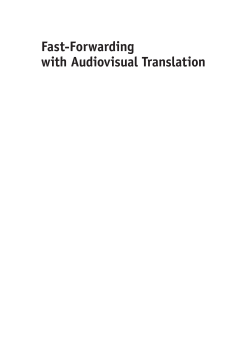
Additional Information
Book Details
Abstract
This edited collection offers a rounded vision of some of the ways in which audiovisual translation (AVT) can be approached from an academic, professional and educational point of view. The studies provide a stimulating and thought-provoking account of some of the most representative themes that are currently being researched in the field of AVT, while also highlighting new directions of potential research from a cognitive perspective. A conscious effort has been made to cover not only cultural and linguistic approaches to traditional domains of AVT (such as dubbing and subtitling), but also to look into lesser known areas of research that are attracting substantial interest from various stakeholders and gradually becoming part of the remit of AVT (including subtitling for the deaf and audio description for the blind). In this respect, the chapters of this book tackle the field of AVT from a plural, comprehensive and up-to-date perspective; speak of a rich and complex academic subject in the making; broaden our existing knowledge on AVT; reflect the many crossroads and junctions it currently faces and outline some of the issues that will become topical in the near future in this fascinating, flourishing discipline.
Jorge Díaz Cintas is Professor of Translation Studies at University College London, UK. He has published extensively in the field of audiovisual translation, subtitling and dubbing and is the editor of New Trends in Audiovisual Translation (2009, Multilingual Matters).
Kristijan Nikolić is Senior Lecturer in Translation at the University of Zagreb, Croatia. He has been a practising subtitler for over 15 years and carries out academic research in the areas of audiovisual translation and interlingual subtitling.
Anyone wishing to know the direction Audiovisual Translation Studies is taking needs only to read this volume to conclude the field is now fully established and thriving. This collection presents new and established topics with rigour and enthusiasm to show how advances in technology, education, the profession and reception are stimulating multi-disciplinary research that derives from both the social and the exact sciences.
An updated and thorough collection of complementary and discerning articles, written by eminent scholars, that reveals how to approach audiovisual translation in the age of digital transformation. This illuminating publication provides a wide-ranging and insightful snapshot of audiovisual translation research today and analyzes a number of substantial changes that are having a considerable impact on the way in which we understand this complex activity.
Fast-Forwarding with Audiovisual Translation provides a comprehensive collection of innovative, invaluable research that contributes to our understanding of major issues in the field and constitutes essential reading for scholars of AVT.
Sharon Black, Queen’s University Belfast, UK
Fast-Forwarding with Audiovisual Translation takes the reader on a journey into the future of the discipline of AVT and related domains. With contributions on state-of-the-art experimental research, on new professional and didactic competences, and on the rapidly changing requirements shaping the field worldwide, this book goes well beyond the traditional case studies approach and paves the way for further research.
Table of Contents
| Section Title | Page | Action | Price |
|---|---|---|---|
| DOI https://doi.org/10.21832/DIAZ9368 | iv | ||
| Contents | v | ||
| Acknowledgements | vii | ||
| Contributors | ix | ||
| Fast-Forwarding with Audiovisual Translation | 1 | ||
| Part 1 Transferring Language and Culture in AVT | 15 | ||
| 1 Globalising Bollywood: My Name Is Khan from India to Italy through Hollywood | 17 | ||
| 2 How to be Indian in Canada, How to Be Indie in Italy: Dubbing a TV Sitcom for Teenagers | 31 | ||
| 3 Censorship and Manipulation of Subtitling in the Arab World | 47 | ||
| Part 2 Reception and Process | 59 | ||
| 4 Do Shot Changes Really Induce the Rereading of Subtitles? | 61 | ||
| 5 Watching Translated Audiovisuals: Does Age Really Matter? | 80 | ||
| 6 Content Selection and Presentation: Considerations in Interlingual Subtitling Inquiry | 93 | ||
| 7 Eye Tracking and the Process of Dubbing Translation | 110 | ||
| Part 3 The Professional Environment | 125 | ||
| 8 Audio Description Crisis Points: The Idea of Common European Audio Description Guidelines Revisited | 127 | ||
| 9 Mapping Subtitling Competence: An Empirical Study of Companies’ Needs and Expectations | 141 | ||
| 10 Developing Subtitling for the Deaf and the Hard-of-Hearing in Turkey | 173 | ||
| Part 4 The Pedagogical Value of AVT | 193 | ||
| 11 The ARDELE Project: Audio Description as a Didactic Tool to Improve (Meta)linguistic Competence in Foreign Language Teaching and Learning | 195 | ||
| 12 Using Audiovisual Translation to Track Language Planning Developments: Flemish Public Broadcasting Subtitles from 1995 to 2012 | 212 | ||
| Index | 225 |
